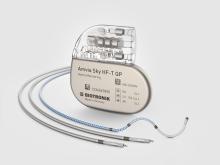BIOTRONIK announced the one-year subgroup results from the investigator-initiated BIOPACT randomized controlled trial (RCT), which were presented by principal investigator Dr. Koen Deloose at LINC, the Leipzig Interventional Course 2023. The randomized controlled non-inferiority trial evaluated the safety and efficacy of the Passeo®-18 Lux® drug-coated balloon (DCB) catheter compared to the In.Pact Admiral DCB (Medtronic) and showed excellent results for both balloons through 12 months across a variety of sub-cohorts. The prospective, multicenter, core-lab adjudicated non-inferiority study enrolled 302 patients in Austria, Belgium, France and Switzerland with Rutherford 2-4 disease.1 Patients were randomized 1:1 to either the Passeo-18 Lux DCB or In.Pact Admiral DCB for the treatment of stenotic, non-stented restenotic or occlusive lesions in the femoropopliteal artery.1 The primary safety endpoint was a composite of freedom from device- and procedure-related death through 30 days post-index procedure
BIOTRONIK, a leading global medical technology company specializing in innovative cardiovascular and endovascular solutions, proudly announces a multinational distribution partnership with Texray, the pioneering developer of a groundbreaking radiation protection textile. In this collaboration BIOTRONIK will distribute Texray's head and neck protectors starting in selected European and Middle Eastern countries. Both partners aim to raise awareness about the critical importance of radiation protection for healthcare professionals, who serve in environments where radiation exposure is an inherent occupational risk. “Texray's radiation protective textiles complement BIOTRONIK’s product portfolio, enhancing our ability to offer customers comprehensive protection solutions. We are delighted to expand our offering, ensuring that healthcare professionals have a range of radiation protection options to support their safety in their daily work,” says John Brumfield, Global Vice President Marketing CRM at BIOTR
Prof. Michael Haude, BIOMAG-I Coordinating Clinical Investigator, presented the latest results of the BIOMAG-I clinical study at the Cardiovascular Research Technologies (CRT) meeting.1 At six months the angiographic and clinical data showed a low in-scaffold late lumen loss (LLL) rate and a good safety profile with no scaffold thrombosis. A low proportion of mal-apposed struts after implantation was observed, at six months struts were no longer discernable. The intravascular imaging documented a preservation of the scaffold area with a low mean neointimal area. Bioresorbable scaffolds have been developed to provide temporary mechanical support, while controlling neointimal proliferation over the vascular healing period and preventing long-term stent-related adverse events. DREAMS 3G, BIOTRONIK’s next generation drug-eluting resorbable Magnesium scaffold (RMS), is made of a proprietary Magnesium alloy and maintains a resorption time of 12 months. Compared to its predecessor DREAMS 2G, it offers unique be
In the first-in-human study BIOMAG-I, BIOTRONIK’s new-generation DREAMS 3G resorbable magnesium scaffold (RMS) showed significantly lower in-scaffold late lumen loss (LLL) than its predecessor at 12 months as well as excellent safety and efficacy. Prof. Michael Haude, BIOMAG-I Coordinating Clinical Investigator, presented the latest results in the late breaking trial session at the EuroPCR course.1 At one-year follow-up, BIOMAG-I data confirmed the excellent safety profile of DREAMS 3G RMS with a low target lesion failure rate of 2.6%. Neither cardiac death and myocardial infarction occurred, nor scaffold thrombosis was reported. After completion of the resorption, the in-scaffold LLL was 0.24±0.36 mm, comparable to contemporary drug-eluting stents (DES).2 “At the end of the scaffold resorption, at 12 months the data showed, that the DREAMS 3G scaffold has an excellent safety and efficacy profile”, said Prof Michael Haude, Rheinland Klinikum, Germany. “The late lumen loss is not just 38% better
BIOTRONIK announces the FDA 510(k) clearance and CE mark of its Oscar® (One Solution: Cross. Adjust. Restore) multifunctional peripheral catheter. Physicians in the U.S. have already used the novel device in more than 70 cases. As indicated per Instructions for Use, Oscar is intended for percutaneous transluminal interventions in the peripheral vasculature. The device was developed to provide support during access into and to dilate stenoses in femoral, popliteal and infrapopliteal arteries. The Oscar peripheral multifunctional catheter is comprised of three user-adjustable components: The Oscar system will be available in 11 total size configurations with either 0.014”/4F or 0.018”/6F guidewire/introducer sheath compatibility. This may massively reduce stock units required compared to a standard PTA balloon. Additional standalone Oscar PTA balloons are also available separately to be used with the Oscar support catheter. The Oscar support catheter and dilator are used in tandem to enable
Results from the MATRIX study show that the high detection accuracy of DX single-lead ICD systems for atrial fibrillation (AF) episodes (99.7% for ≥ 1h episodes) in combination with the strong transmission performance of BIOTRONIK Home Monitoring® allows for reliable guideline-recommended remote monitoring of subclinical AF. The findings were published in Europace earlier this week.1MATRIX evaluated the utility of the DX-ICD system (atrial signal detection via a floating dipole integrated in the ICD lead) for remotely monitoring atrial high-rate episodes (AHRE) and their duration progression. In addition, the study analyzed the clinical implications of AHRE detection and progression. The outcome of the study should be interpreted in the context of the 2020 European Society of Cardiology’s guidelines on AF which recommend remote monitoring of device-detected AHRE and provide further guidance depending on the AF burden along pre-specified duration strata.The study was led by Prof. Dr. Gerhard Hindricks, De
Find useful downloadable assets and press kits
